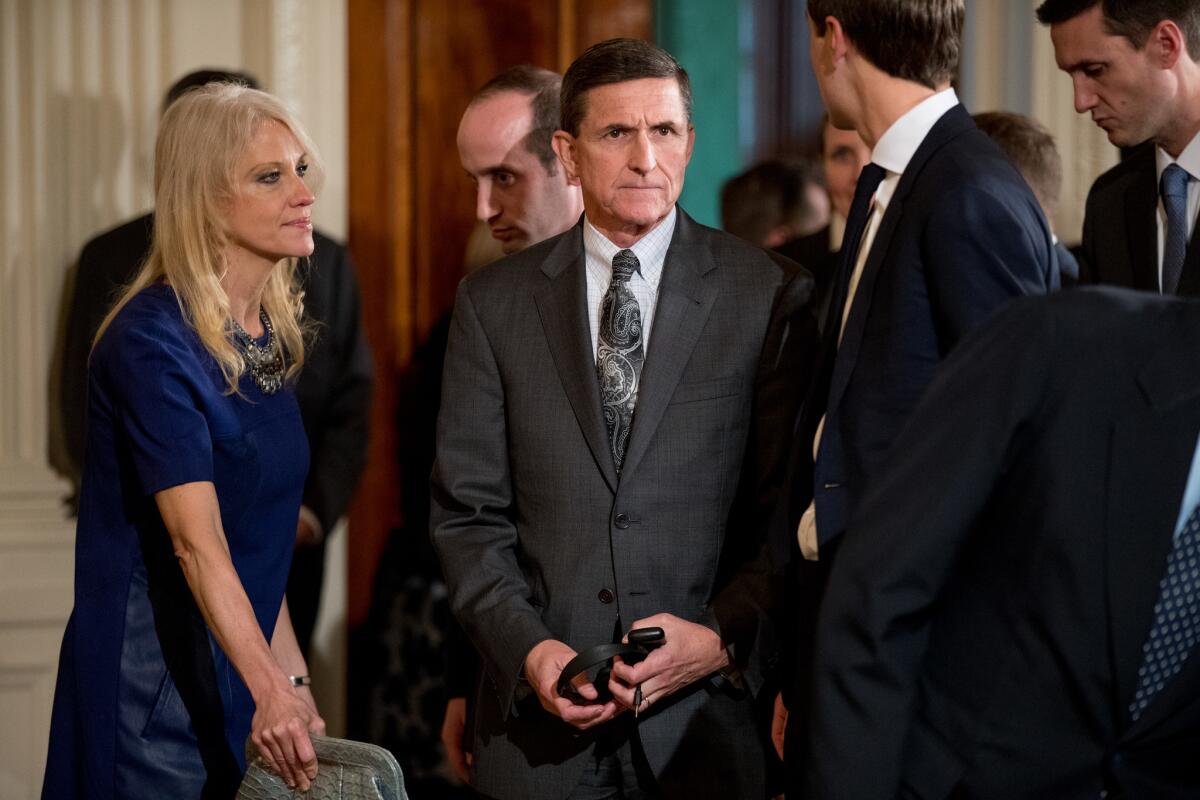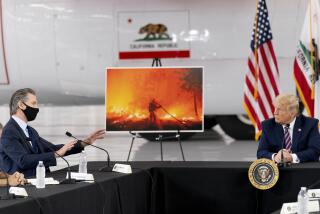Timeline: What we know about the events leading to Michael Flynn’s resignation

Less than a month in to the new administration, President Trump’s national security advisor, Gen. Michael Flynn, has resigned after admitting that he misled his White House colleagues, including Vice President Mike Pence, about conversations he’d had with Russia’s ambassador to Washington.
In those conversations, officials say, Flynn discussed sanctions that the Obama administration had imposed on Russia to punish Moscow for its interference in the U.S. election. Those conversations could have violated the Logan Act, which prevents unauthorized citizens from negotiating with foreign governments in relation to “disputes or controversies.” The law, however, which was enacted in the 1790s, has never been used to prosecute anyone.
Here’s the timeline of events leading up to Flynn’s resignation:
- Nov. 18: Trump names Flynn as his choice for national security advisor. The decision was controversial from the start. Flynn had attended a lavish dinner in Moscow in 2015 at which he sat next to President Vladimir Putin and also received a speaking fee from a Russian television network that U.S. officials consider a propaganda outlet.
- Dec. 6: Trump’s transition team cuts ties with Flynn’s son, who had spread false stories on Twitter.
- Dec. 29: The Obama administration imposes sanctions on Russia in retaliation for Russia’s hacking of the Democratic National Committee in the summer and other efforts to interfere with the U.S. election. Flynn contacts Russian Ambassador Sergey Kislyak several times that day, including more than one telephone call. (White House officials initially said the calls were made the previous day, but later corrected themselves.)
- Dec. 30: Putin says he will not retaliate against the U.S. sanctions, surprising the Obama administration. Trump praises Putin.
- Early January: Intelligence officials, looking for clues to why Putin decided not to retaliate, discover Flynn’s conversations with Kislyak, whose communications the U.S. government routinely monitor.
- Jan. 11: At a news conference, Trump denies that he has ties with Russia.
- Jan. 12: Washington Post columnist David Ignatius first reports on Flynn’s contacts with Kislyak. “What did Flynn say,” he asks, “and did it undercut the U.S. sanctions?”
- Jan. 13: Trump transition spokesman Sean Spicer denies that Flynn and Kislyak discussed sanctions.
- Jan. 15: Vice President-elect Mike Pence, in an interview on CBS’ “Face the Nation,” denies that Flynn discussed sanctions with Kislyak. The timing was “strictly coincidental,” Pence said. “What I can confirm, having spoken to him about it, is that those conversations ... had nothing whatsoever to do with those sanctions.”
- Jan. 20: Trump is inaugurated.
- Jan. 22: Flynn is sworn in as national security advisor.
- Between Jan. 22 and Jan. 26: The FBI interviews Flynn about his contacts with Kislyak.
- Jan. 23: Spicer, now White House press secretary, tells reporters at the daily news briefing that he had talked with Flynn the night before about the calls with Kislyak and that there had been no discussion of sanctions.
- Jan. 26: Acting Atty. Gen. Sally Yates tells White House Counsel Donald McGahn that Flynn and Kislyak had discussed the sanctions and that Flynn, having misled Pence and others, might be subject to Russian blackmail. McGahn briefs Trump.
- Feb. 8: Flynn, responding to questions from the Washington Post, once again flatly denies any discussions with Kislyak about sanctions.
- Feb. 9: A spokesperson for Flynn retracts that denial, saying he does not remember talking about the sanctions, but “can’t be 100% sure.”
- Feb 9: Pence discovers for the first time, from a Washington Post article, that Flynn had misled him, his spokesman confirms. Pence subsequently learns that Trump had known about Flynn’s deception since Jan. 26, but hadn’t told him.
- Feb. 10: Trump, asked by reporters on Air Force One, says he is not familiar with the Post report.
- Feb 10: White House officials say Flynn has called Pence to apologize for misleading him.
- Feb. 12: White House official Stephen Miller, dispatched by the administration to appear on several Sunday TV interview programs, declines to say whether Trump has confidence in Flynn.
- Feb. 13, about 4 p.m. EST: Trump advisor Kellyanne Conway says Flynn has Trump’s full confidence.
- Feb. 13, about 5 p.m. EST: Spicer says Trump is “evaluating the situation.”
- Feb. 13, about 9:30 p.m. EST: The Post and the New York Times disclose that Yates had warned the White House about Flynn’s conversations.
- Feb. 13, 11 p.m. EST: White House announces Flynn’s resignation. Officials say he chose to step down.
- Feb. 14: Spicer says at the daily news briefing that the White House has been investigating Flynn’s conduct for more than two weeks and that he had been fired because of an “eroding level of trust.”
- Feb. 14: Several hours after Spicer’s briefing, Pence spokesman Marc Lotter says that the vice president “became aware of incomplete information that he’d received on February 9 — last Thursday night — based on media accounts. He did an inquiry based on those media accounts.”
Twitter: @cshalby
More to Read
Get the L.A. Times Politics newsletter
Deeply reported insights into legislation, politics and policy from Sacramento, Washington and beyond. In your inbox three times per week.
You may occasionally receive promotional content from the Los Angeles Times.











